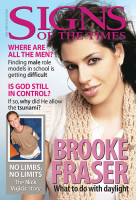We are in the middle of a “new information order,” a revolution that's spawned dissenting grimaces such as, “Whoa, too much information!” and, “Don't go there!”
Few will be exempt from the reach of this new order. News network CNN already reaches some 800 million persons in 200-plus nations. My four-year-old, who has trouble pronouncing our surname, can say with broadcaster-clarity, “Daddy, I want to watch Disney on Foxtel Digital”! And Foxtel and Sky throw dozens of channels out to consumers around the world.
A central part of the new information order is the ubiquitous Internet with its provision for electronic mail (email), web sites (advertising) and the instantaneous chat facility, ICQ (literally, “I-Seek-You”). Australian Internet subscriber numbers passed five million in March 2003, up 11 per cent over six months. The overwhelming majority of these new subscribers are in the “household” sector. In 2003 there were 554 Internet Service Providers (ISPs) in Australia supplying and facilitating access to chat rooms, links, imaging, file sharing, streaming and sound recording. All of which renders impossible an accurate assessment of the number of Internet users. No-one can know for certain how many share the same screen.
One American survey found 53 per cent of all Internet users checked their email at least six times a day; one-third of users spent all day online.
The latest Internet facility is the flourishing “blog”—the (usually opinionated) biographical log that is created and accessed by mostly wealthier professional men. In mid-2003 there were three million bloggers.
The number of mobile phones has also grown exponentially. Globally, in 1990, there were about 11 million of them; by 2000, 440 million; and, as of October 2003, according to cellular.co.za, some 1.32 billion. Increasingly, they have become strategic for sending and using SMS—some 366 billion messages were tapped around the world in 2002.
In the new information order, nothing is so restless as technology. No sooner is one medium or format settled than another arrives with the fanfare normally reserved for European royalty. No sooner was digital music on CDs, than the superior advantages of CD-ROM, DVD and HDTV were trumpeted. Now blue-laser (rather than red) technology is about to go. More upgrading, more plastic exchanges, and more debt. Debt is built into our addiction to the new order.
But perhaps the worst aspect of the new information order is its narrowing of our cultural taste and our diminishing appreciation of what is really worthwhile. As is typical of global TV soaps, we're now “educated” to prefer only news, music and documentary programs that are similarly characterised by high-gloss, videogenic hosts, glamorous sets and visually pleasing locations. We've been trained to want more action and physicality in our media diet, more Hollywood-style narratives to accompany even the most ordinary event, and melodrama.
Nowhere is this most apparent than in the presentation of news on global channels. There, a “story” is considered dull unless it can include on-location action, the immediacy of pictures and images, and events (rather than issues or principles) that dominate the agenda. Add repetition and lack of historical or cultural perspective to the pictorialised event and this is what passes for news analysis.
It is becoming increasingly difficult to take a genuinely critical perspective. Few care about responding to questions of whose media, whose ideas and whose culture are being expressed in the new information order.
While social commentators worry that it may be “American” rather than local or global culture, a more pressing question that's rarely addressed is whether its content and impact are benign or evil. And whether the new information order isn't just the latest expression of the same “old information order” that was first whispered in Eden.



